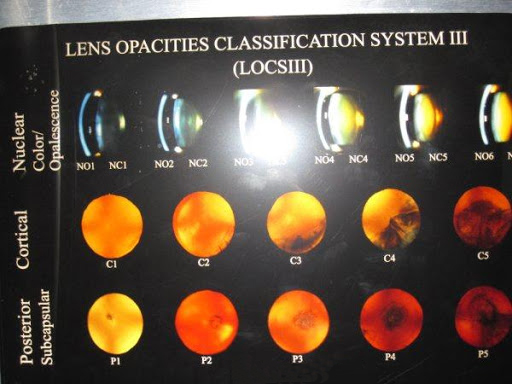Cataract is the clouding of the natural lens in the eye. The natural lens in the eye (called crystalline lens) is a convex lens made up of proteins and is transparent. Its function is to converge light rays and help to focus them on the retina (which is like a screen on which image is formed). The opacification of this lens is termed as cataract.
While cataract can occur at any age and due to a number of reasons, the majority of the cases are age related, typically seen after the age of 50 yrs. There are also other known causes of cataract like diabetes, prolonged use of steroid medication (oral or as eye drops), genetic, trauma, etc.
Morphologically Cataract can be of 3 Main Types

- Nuclear cataract, in which the entire lens shows change in colour to yellow-brown and an increase in density (or hardness of the cataract). This process starts in the core of the lens, hence nuclear cataract. In these patients there is an induced negative spectacle number, which can compensate for the positive number needed for near vision. This may reduce the patient’s need for near vision glasses in the early stages. However as days pass opacities appear in the lens, which blurs the vision for both distance and near.
- Cortical cataract, in which the outer portions of the lens become white and cloudy and there is progressive build-up of water within the lens. These water clefts in the lens can cause multiple images to form, so that the patient sometimes sees double or multiple images of a single object. With time there is progressive blurring of vision. In this type of cataract, in the advanced stages, the lens could swell with water and increase the pressure inside the eye (intra-ocular pressure). This rise of pressure could potentially damage the optic nerve of the eye and cause permanent dimness of vision.
- Posterior sub-capsular cataract, in which the central, back part of the lens develops white opacities. In such patients there is glare (spreading of light) typically in bright sunlight and also at night while facing the headlights of a car. They also complaint of poor near vision.
Treatment of Cataract
Irrespective of the type and cause of cataract, there is only one definitive solution to cataract which is to remove the opaque lens (cataract) surgically and replace it with an artificial one. The surgery is typically advised when the patient starts having visual complaints. Since modern technique involves removing the cataract by emulsifying it (liquefying it), it is advisable that the cataract be removed in the earlier stages when the density (hardness) of the cataract is less. This makes the surgical outcome predictable and reduces the visual recovery time.
The surgery involves making a small 2mm incision (surgical opening) in the eye, through which the procedure is performed under an operating microscope. The cataractous lens is split into pieces and each piece is emulsified and sucked out of the eye by specialised instruments. At the end, an artificial foldable lens is placed in the eye in the capsular support that originally covered the natural lens. The procedure usually takes 20 minutes and there is no need to give injection to the eye. Anaesthesia is achieved by putting eye drops. There is no need to use sutures (stitches). There is also no need to patch the eye. Black goggles are also not required. The patient is discharged immediately following surgery and no hospital stay is needed.
